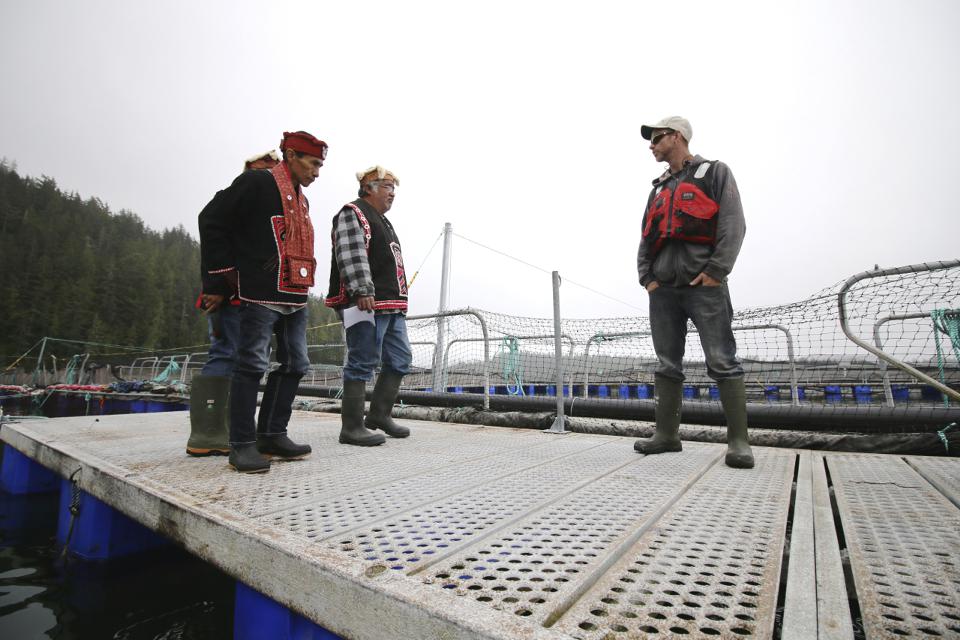
by Deep Green Resistance News Service | Sep 1, 2016 | Lobbying
Featured image: Leaders from Musgamagw Dzawada’enuxw First Nation recently boarded a BC fish farm to serve an eviction notice. Photo by Alexandra Morton.
By Andrew Nikiforuk / The Tyee
The Musgamagw Dzawada’enuxw, whose traditional lands includes much of the Broughton Archipelago, have boarded two Japanese-owned fish farms and delivered eviction orders to remove their operations from unceded territories over the last six days.
On Aug. 15, three Dzawada’enuxw traditional leaders served an eviction notice to a Cermaq/Mitsubishi salmon farm on the Burdwood Islands, and on Aug. 18 boats from the communities of Gwayasdums (Gilford Island), U’kwa’nalis (Kingcome Inlet) and Alert Bay arrived at the Sir Edmund Bay fish farms run by Cermaq/Mitsubishi to conduct a cleansing ceremony.
Melissa Willie, an elected councillor for the nation, said about 40 people participated in the cleansing ceremony and that more demonstrations are planned later this week.
Willie said a cleansing ceremony was necessary because fish farms have been clouded by a lot of “negativity” and environmental impacts, and her people wanted to do something positive.
“We will do a cleansing of our waters once we get these fish farms out,” Willie told The Tyee.
The Martin Sheen, a research vessel loaned by the Sea Shepherd Conservation Society to biologist and anti-fish farm activist Alexandra Morton, witnessed and filmed the delivery of the eviction notice as well as the cleansing ceremony.
Morton, a long-term foe of the controversial industry, is on a two-month mission to investigate the state of corporate fish farms, do research on virus prevalence, and provide a platform for First Nations.
Some nations support fish farms on their territory, while others such as Musgamagw Dzawada’enuxw have been fighting them and their impacts on wild fish for 30 years.
The eviction notice follows a number of developments, including the federal government’s decision to extend fish farm licences from one to six years despite recent evidence found by federal scientists of a “potential” heart disease in farmed Atlantic salmon samples collected from one B.C. fish farm.
Members of the Musgamagw Dzawada’enuxw were also shocked earlier this month when Melissa Willie visited a Cermaq farm and opened the lid of a blue-coloured tote containing dead fish netted from the facility.
Both Willie and Morton identified what they said looked like several wild salmon and other native fish (possibly herring and eulachon) in the pile. Fish farms do not have a licence to feed or harvest wild fish.
But in an Aug. 18 press release, Cermaq denied the dead fish were wild and said they were young farmed salmon.
“The small salmon carcasses found in the mort totes are Atlantic salmon grown from our own broodstock, not Pacific wild salmon as alleged. In fact, the tote in question was at our broodstock site, where we grow salmon that are several years apart in age. The age difference results in both small and large fish that, if they die, go into the same tote,” explained their press release.
Willie disagreed with Cermaq’s view of things.
“Wherever you have fish farms, there will be wild fish entering those pens. It is common sense. We all know that the herring stay by some of the farms and feed there.”
In the same press release, Cermaq accused the Sea Shepherd Society of trespassing on private property, making unsubstantiated claims, and having “taken samples of dead fish without permission and without following any proper scientific procedures.”
In contrast, Willie said her people would like to thank Sea Shepherd for joining them in their fight.
Notice gives three months to pack up
The eviction notice gives the corporate farms three months to pack up their operations.
It also demands that no more farmed fish be transferred into the First Nation’s traditional territory and that the nation be allowed to take fish samples from the farms anytime it wants to determine what types of disease or parasites might be present.
“The people who are benefiting from these farms are benefiting over the suffering of our people,” said Dzawada’enuxw hereditary leader Farron Soukochoff in a press release.
The Musgamagw Dzawada’enuxw First Nations have opposed corporate salmon farming on the grounds that open-net feedlots invite diseases and waste that have had a deleterious impact on wild fish, including herring and five varieties of Pacific salmon.
“We, the Musgamagw Dzawada’enuxw view the destruction of wild fish by the fish farming industry as part of the long history of genocide forced on our people by the governments of Canada,” reads an Aug. 18 press release. “Salmon are essential to our well-being and the well-being of our world.”
According to a recent report, the number of young wild salmon leaving Dzawada’enuxw territory in the spring of 2015 could have been reduced by nine to 39 per cent due to sea lice from salmon farms.
Along with the eviction notice, the Musgamagw Dzawada’enuxw have set up a website called “cleansing our waters.”
Approximately one-third of the corporate feedlots growing Atlantic salmon along B.C.’s coast are located on Dzawada’enuxw territory.
A 2008 scientific study found that wild salmon populations declined wherever corporations have set up industrial fish farms in the ocean including Norway, Scotland, Ireland and Canada.
“We have heard the words of Prime Minister Justin Trudeau, that honouring the rights of First Nations are a ‘sacred obligation’ to the Liberal Government of Canada,” said Musgamagw Dzawada’enuxw hereditary leader and chief councillor Willie Moon at a cleansing ceremony at the Sir Edmund salmon farm at the entrance to Kingcome Inlet.
“Our people have spoken: we want salmon farms out of our territory.”
In a prepared statement, Jeremy Dunn, executive director of the BC Salmon Farmers Association, said that the industry has 20 agreements with First Nations that cover “78 per cent of the annual harvest of farmed salmon.”
“Our members are always open to meeting and discussing issues with First Nations and would like to develop agreements in areas where they do not exist today,” added the statement.
Dunn told The Tyee that many First Nations have tried to evict corporate farms in the past but later signed financial agreements with the industry.
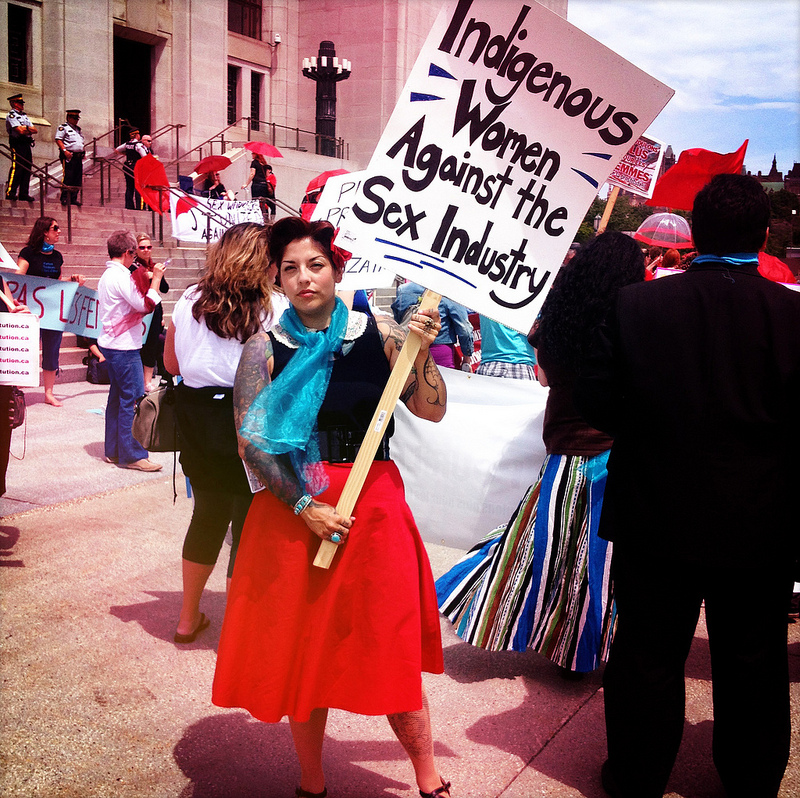
by Deep Green Resistance News Service | Jun 19, 2016 | Prostitution
By Cherry Smiley / Feminist Current
The full decriminalization of prostitution has received considerable mainstream media attention of late: On May 5, the New York Times published an article by Emily Bazelon called, “Should Prostitution be a Crime?” and on May 26, Amnesty International formally adopted a position in favour of the total decriminalization of prostitution.
Neither Bazelon’s article nor Amnesty International’s “sex work” policy take into meaningful account the ways in which prostitution functions as a system of colonialism that disproportionately targets Indigenous women and girls. Through these policies and positions, prostitution is sanitized and whitewashed into “sex work,” leaving Indigenous women and girls and our sisters of colour to deal with the consequences.
Today, as the result of the sustained work of Indigenous women and men, increasing numbers of individuals and organizations are beginning to recognize the importance of land to the survival, cultures, and well-being of Indigenous Peoples and the ways in which colonialism violently disrupts these relationships. Slowly, non-Indigenous people are beginning to understand the concept of “unceded territories” and acknowledge the exploitation of lands and “resources” that were forcibly removed from the care of Indigenous Peoples.
Male colonizers were thieves who took what wasn’t theirs because they believed they were entitled to it. But this entitlement didn’t stop at lands — these men decided they were also entitled to the bodies of Indigenous women and girls. According to research done by Melissa Farley, Jacqueline Lynne, and Ann Cotton, Indigenous women and girls in Canada were prostituted through early forts and military bases, and as “country wives” of white fur traders. Indigenous women and girls were targeted for prostitution in part because of lies told about them: they were “squaws” and “savages” who always wanted sex with white men. Prior to the invasion of North America, prostitution didn’t exist among the Indigenous Nations I have encountered — rather, prostitution was imposed on Indigenous women and girls by male colonizers. Entitlement to land continues today as non-Indigenous people live on and exploit Indigenous lands for profit, and entitlement to bodies continues in crisis levels of male violence against Indigenous women and girls.
In her article, Bazelon quotes Liesl Gerntholtz, Executive Director of the Women’s Rights Division at Human Rights Watch (HRW), another organization that has taken a position supporting the total decriminalization of prostitution:
“You’re often talking about women who have extremely limited choices. Would I like to live in a world where no one has to do sex work? Absolutely. But that’s not the case. So I want to live in a world where women do it largely voluntarily, in a way that is safe.”
Gerntholtz and HRW have apparently concluded that it is impossible to imagine a world without prostitution and, in doing so, disregard Indigenous histories and send the message to Indigenous women and girls that we are not worth fighting for. In taking this position, HRW reaffirms the racist myth that Indigenous women and girls (and women of colour) are disproportionately consenting to engage in prostitution because they so desire sex with white men. If we don’t recognize and fight back against the racist, sexist, and capitalist inequalities that funnel women and girls into prostitution and fight back against male entitlement, our only answer to the overrepresentation of Indigenous women and girls in the sex industry becomes: “Because they are ‘squaws’ who desire sex with strangers in disproportionate numbers to white women.” Is this the lie we want to continue to tell to Indigenous women and girls and the message we want to send to the men who buy and sell them?
Unfortunately, Bazelon and HRW can’t (or won’t) challenge male entitlement. Instead, women and girls are told they simply need to find better and “safer” ways to accommodate unchallenged male entitlement to our bodies.
The messages I received from the time I was a girl were meant to keep me “safer”: don’t talk to strangers, don’t walk alone at night, don’t wear short skirts. This messaging (always directed at girls and women) aims to constrain our movements and actions in the name of “safety.” Where is the messaging to boys and men not to rape? Where is the messenging that tells men and boys that they are not entitled to sex whenever, however, and with whoever they want? Where is the challenge to male entitlement to bodies and lands?
We see examples of male entitlement everywhere. The recent case of the Stanford rapist, Brock Turner, is a perfect example. His actions, as well as the light sentence, defence, minimization, and disbelief of Turner’s actions by his father and others, is an example of rape culture: a culture that allows, condones, and even celebrates the rape of women and girls by men. This culture affects all women and girls, but Indigenous women and women of colour in particular ways, leading one to question whether Turner would have even been charged or convicted had his victim been Indigenous or a woman of colour.
Watching these cases, Indigenous women and women of colour see that even a woman with white privilege received a horrific response to her sexual assault, leading us to ask, “If this happened to a woman with a relative level of privilege, what will happen to us?” Regardless of the race of the victim, what all women live through as victims of sexual assault and the ways our lives are constrained by male violence (or the threat of male violence) is a direct result of the patriarchal culture we live in.
Turner raped a woman because he felt entitled to her body. Male entitlement is a foundation of rape culture, yet many who claim to criticize rape culture simultaneously support the decriminalization of pimps and johns, thereby failing to recognize that the very same male entitlement that supports rape culture also fuels the sex industry.
Amnesty says their new policy, “does not argue that there is a human right to buy sex or a human right to financially benefit from the sale of sex by another person.” What the organization doesn’t seem to realize is that, without consequences for the actions of pimps and johns, their policy green-lights and condones those actions. Amnesty International’s policy naturalizes male entitlement to bodies (and lands) by refusing to acknowledge it as part of the foundation of patriarchy, racism, and capitalism and by refusing to challenge it accordingly.
To be clear, I am critiquing the system of prostitution, not the women and girls who are in prostitution. In the same way, I critique Canada’s horrific residential school system without criticizing residential school survivors and critique rape culture without blaming women and girls who have been raped. There is no shame in engaging in prostitution; Indigenous women and girls have been targeted for prostitution since the invasion of Canada by white men. The fact that Indigenous women and girls survive at all in a genocidal culture that hates us and hates all women is nothing short of a victory. But we deserve more than just survival — we deserve fulfilling, joyful lives that are free from male violence or the threat of male violence. We deserve to engage in sexual acts of our choosing, with partners that we choose, who consider our humanity and pleasure, without any form of threat or coercion, economic or otherwise. All those who sell sex should of course be decriminalized and all women and girls should have access to the things we need to build those fulfilling, joyful lives, like safe and affordable housing, nutritious food and clean water, access to education and employment opportunities, and a recognition of our rights to our lands, languages, and cultures. I don’t judge those who find themselves selling sex, but I do judge the men who choose to pay for or profit from the sexual exploitation of women and girls — the vast majority of whom are poor, Indigenous, and of colour. In Canada today, girls are sexualized from a very young age and women still only earn 72 per cent of what men earn for similar work; let’s not pretend girls begin their lives on equal footing.
I’ve witnessed a lot of online praise for Bazelon’s article and Amnesty International’s new policy, and sadly, I’m unsurprised at this show of support. When the status quo (male entitlement) isn’t being challenged, celebration is to be expected. I’m sure many johns and pimps applauded Bazelon’s article and Amnesty’s new sex work policy.
A number of well-meaning individuals and organizations refer to reports by HRW and Amnesty International regarding violence against Indigenous women and girls in Canada as important research in regard to this issue. However, due to these organizations’ position on prostitution, it is obvious to me that neither has an understanding of colonialism and the consequences of this ongoing process on the lives of Indigenous women and girls. Human Rights Watch, Amnesty International, and Bazelon fail to understand that, on a fundamental level, white male entitlement to bodies and lands is harmful and sometimes deadly, and that white male entitlement to bodies and lands must always be challenged. Prostitution is the colonization of bodies, and at its heart, is an expression of patriarchy, racism, and capitalism. This is about wealthy, white male domination and control.
I suggest that writers like Bazelon educate themselves further on colonialism and what it means before publishing further on these issues, and that HRW and Amnesty International refrain from commenting on any issue of male violence against Indigenous women and girls in Canada until they are willing to take a stand against male entitlement to women’s bodies and lands.
These positions and arguments are contradictory and cannot be reconciled to advocate for an end to violence against Indigenous women and girls on one hand, and for pimps and johns to buy and sell Indigenous women, without consequence, on the other. Indigenous women and girls don’t need “allies” that refuse to challenge colonialism in Canada and colonial ideologies within themselves.
Cherry Smiley is a feminist activist and artist from the Thompson and Navajo nations. She is a co-founder of Indigenous Women Against the Sex Industry and was the recipient of a 2013 Governor General’s Award in Commemoration of the Person’s Case and the 2014 winner of The Nora and Ted Sterling Prize in Support of Controversy. Follow her .
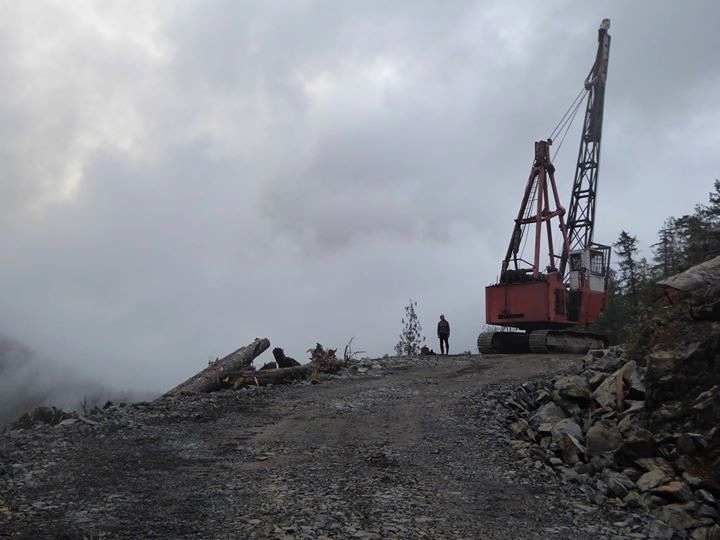
by Deep Green Resistance News Service | Apr 27, 2016 | Biodiversity & Habitat Destruction, Strategy & Analysis
By Zoe Blunt / WildCoast.ca
“I’m in love. With salmon, with trees outside my window, with baby lampreys living in sandy streambottoms, with slender salamanders crawling through the duff. And if you love, you act to defend your beloved.” — Derrick Jensen
Pacific Coast people have always defended the places we love. Most of British Columbia is unceded indigenous land; native peoples have never abandoned, sold, or traded their land away. Many fought fiercely against the power of the British Empire. Cannonballs are sometimes still found embedded in centuries-old trees along the shore – leftovers from the gunboats that tried to suppress indigenous uprisings in the late 1800s.
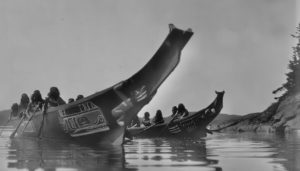
Nuu-chah-nulth war canoes (Edward Curtis, BC Historical Society)
A century later, descendants of the settlers have joined forces to battle corporate raiders. In the 1980s and 1990s, a groundswell of eco-organizing brought thousands of people together to stop clearcut logging in the cathedral forests of Vancouver Island’s Pacific coast, where timber companies were busy converting ten-thousand-year-old ecosystems into barren stumpfields and pulp for paper.
During those years, police arrested hundreds in Clayoquot Sound and the Walbran Valley at mass civil disobedience protests. Young and old alike sat in the middle of the logging roads and linked arms. The resistance went far beyond the peaceful and symbolic: unknown individuals spiked thousands of trees to make the timber dangerous to sawmills. Shadowy figures burned logging bridges and vandalized equipment. The skirmishes went on for over a decade.
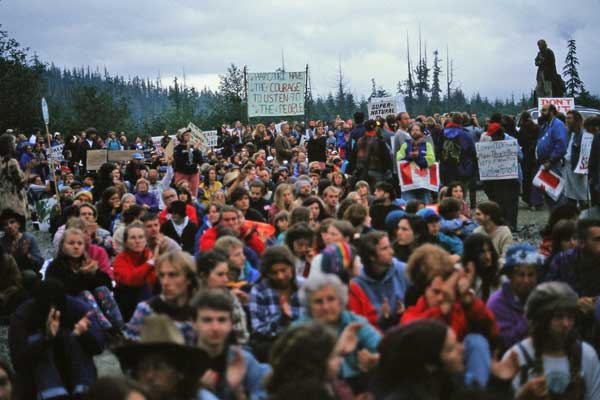
Clayoquot Sound, 1993
We won a few battles. Several coastal valleys are protected as parks. But many of them have been logged. And now the logging companies are coming back for the valleys that remain unprotected.
One of the worst corporate offenders is Teal Jones, the company currently bulldozing the majestic Walbran Valley, two hours west of Victoria, BC. They are laying waste to a vibrant rainforest for short-term profit, without the consent of the Pacheedaht First Nation, the Qwa-ba-diwa people, or anyone else outside of government and industry. Teal Jones does not even own the land; it was taken from indigenous people in the name of the BC government sixty years ago.
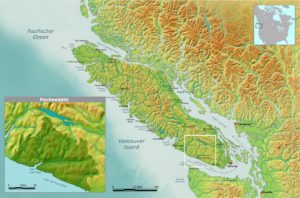
Pacheedaht territory, Vancouver Island BC
This year, the elected leadership of the Pacheedaht First Nation threw its support behind building a longhouse in the contested valley, on the land that has sustained them for countless generations. At the same time, locals are pushing back against the logging by occupying roads and logging sites. This in spite of the company’s court order telling police to arrest anyone who blocks their work. Forest defenders are regrouping, but the destruction continues.
Women for the Walbran and Forest Action Network are ramping up to break the deadlock. We’re hosting direct action trainings to share skills and develop strategies for defending ecosystems. The agenda includes tactics like non-violent civil disobedience, occupying tree-tops, and backcountry stealth. We’ll have info on legal rights, indigenous solidarity, and more.

Tree-sit occupation, Langford BC. (Photo: Ingmar Lee)
Our adversary, Teal Jones, is a relatively small company. Its owners are relying on the police to protect their “right” to strip public forests on Pacheedaht traditional territory. Profit margins are slim, and lawyers are expensive. The forest defenders are poor, but we have community support and a wide array of strategies for beating Teal Jones at its own game. Every tool in the box: we can launch a mass civil disobedience campaign, carry out hit-and-run raids on costly machines, coordinate a knockout legal strategy, or deliver the tried-and-true “death by a thousand cuts” with a combination of tactics.
However it plays out, Teal Jones is on borrowed time in the Walbran. But that’s cold comfort when the machines are mowing down thousand-year-old forests like grass.

Photo: Walbran Central
The forest defenders do have certain advantages. On the practical side, we’re investing in the gear and training that will provide the leverage to win. We have a legal defense fund that’s both a war chest for litigation and a safety net for those who risk their freedom on the front lines. But our best defense is the thousands of people who love this land like life itself. Many live nearby and visit every chance they get, others came once and fell in love, and untold numbers have yet to see the Walbran’s wildlife firsthand, but they hold it in their hearts.
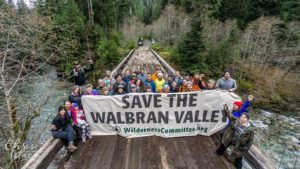
Photo: Walbran Central
Those who love the land are a community. We are the organizers, sponsors, and volunteers who drive this movement forward. Everyone who shares these values can be a part of it; no contribution is too small. We’re going all-out to defend the forests, rivers, bears, cougars, otters, and eagles of the Walbran Valley. They sustain us and we give back by fighting to protect them.

Walbran River, the heart of the Walbran Valley, spring 2016. (Photo: Walbran Central)
Remember: Forest Defenders Are Heroes!
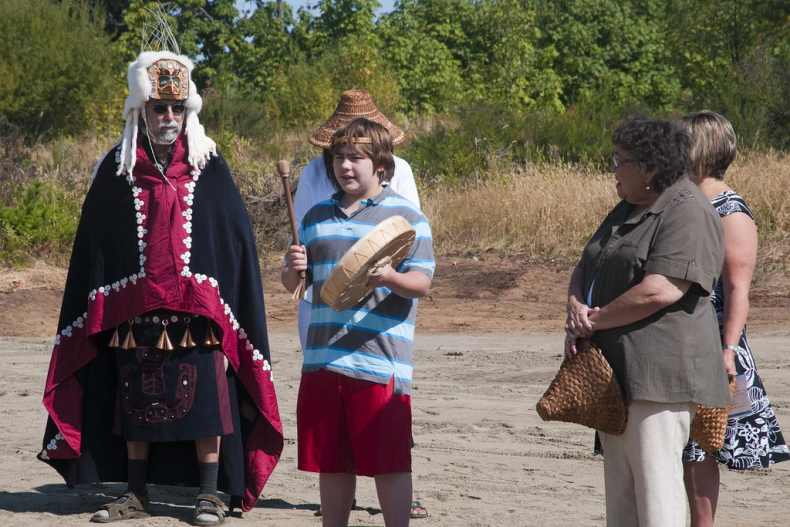
by Deep Green Resistance News Service | Apr 18, 2016 | Alienation & Mental Health, Indigenous Autonomy
Featured image: An indigenous youth from Kwalikum First Nation sings. Photo: VIUDeepBay @flickr. Some Rights Reserved.
By Courtney Parker and John Ahni Schertow / Intercontinental Cry
The spiraling rate of suicide among Canada’s First Nations became a state of crisis in Attawapiskat this week after 11 people in the northern Ontario community attempted to take their own lives in one night.
The First Nation was so completely overwhelmed by the spike in suicide attempts that leaders declared a state of emergency. Crisis teams were soon deployed by various agencies to help the community cope with the horror. Meanwhile, as news coverage of the shocking situation spread, activists occupied the Toronto office of Indigenous and Northern Affairs to demand the federal government provide immediate and long-term support to properly address the situation in Attawapiskat.
At least 100 people from the small Cree community have attempted suicide since September. This alarming number—5 per cent of Attawapiskat’s population—is symptomatic of a larger and more pervasive problem in Canada.
While cancer and heart disease are the leading causes of death for the average Canadian, for First Nations youth and adults up to 44 years of age the leading cause of death is suicide and self-inflicted injuries.
According to Health Canada, the suicide rate for First Nations male youth (age 15-24) is 126 per 100,000 compared to 24 per 100,000 for non-indigenous male youth. For First Nations women, the suicide rate is 35 per 100,000 compared to 5 per 100,000 for non-indigenous women.
Handling this situation through a lens of crisis management simply will not do.
In order to bring an end to this long-standing crisis, there are systemic, cyclical and multi-generational issues that must first be addressed, with special attention given to ongoing disruptions in individual and cultural identity.
Historical impacts of colonization, compounded by Canada’s ongoing policies of forced assimilation, are pulling today’s First Nation youth further and further away from their core cultural identities. These identities and cultures have the power to protect and sustain all First Nation youth, and provide them with the resilience they need to overcome whatever individual factors may place them at risk for suicide.
Noting that the Pimicikamak Cree Nation in central Manitoba also responded to the epidemic by declaring their own state of emergency in March, national chief of the Assembly of First Nations, Perry Bellegarde recently proclaimed:
“We need a sustained commitment to address longstanding issues that lead to hopelessness among our peoples, particularly the youth.”
Bellegarde further lamented the lack of specially trained community health workers. He also cited Attawapiskat First Nation’s need for a mental health worker, a youth worker, and proper fiscal support to train workers in the community to respond.
Mainstream media has its own role to play.
Research has shown that merely talking about the devastating indigenous suicide epidemic can have unspeakably damaging consequences.
In 2007, a Canadian research team compiled a comprehensive report entitled, “Suicide Among Aboriginal People in Canada.” The text goes into great detail about how the media should—and should not—handle this extremely delicate subject matter.
“Mass media—in the form of television, Internet, magazines, and music—play an important role in the lives of most contemporary young people. Mass media may influence the rate and pattern of suicide in the general population (Pirkis and Blood, 2001; Stack, 2003; 2005). The media representation of suicides may contribute to suicide clusters. Suicide commands public and government attention and is often perceived as a powerful issue to use in political debates. This focus, however, can inadvertently legitimize suicide as a form of political protest and thus increase its prevalence. Research has shown that reports on youth suicide in newspapers or entertainment media have been associated with increased levels of suicidal behaviour among exposed persons (Phillips and Cartensen, 1986; Phillips, Lesyna,and Paight, 1992; Pirkis and Blood, 2001). The intensity of this effect may depend on how strongly vulnerable individuals identify with the suicides portrayed.
Phillips and colleagues (1992) offer explicit recommendations on the media handling of suicides to reduce this contagion effect. The emphasis is on limiting the degree of coverage of suicides, avoiding romanticizing the action, and presenting alternatives. There is some evidence that this may actually reduce suicides that follow in the wake of media reporting (Stack, 2003). Many Canadian newspaper editors have adopted policies to minimize the reporting of suicide to reduce their negative impact (Pell and Watters, 1982). Suicide prevention materials can also be disseminated through the media. The media can also contribute to mental health promotion more broadly by presenting positive images of Aboriginal cultures and examples of successful coping and community development.”
Even greater than the need for more socially responsible media, is the need for more proactive and community-specific solutions on the ground.
There is a growing body of evidence demonstrating the value of taking protective measures to prevent suicide by preserving and promoting the regular use of traditional indigenous languages.
In 2008, researchers Chandler and Lalonde published a report entitled, “Cultural Continuity as a Protective Factor Against Suicide in First Nations Youth.” In their review, they touched on an inherent risk in raising the conversation on the indigenous suicide epidemic to the international level – though it is particularly severe in Canada, it is indeed global – describing how it may obstruct community-based and community-specific solutions from emerging. Findings also confirmed that individual and community markers of cultural continuity – such as language retention – can form a protective barrier against the staggering incidence rates of suicide ravaging First Nations like Attawapiskat and the Pimicikamak Cree Nation.
Chandler and Lalonde conclude that:
“First Nations communities that succeed in taking steps to preserve their heritage culture, and that work to control their own destinies, are dramatically more successful in insulating their youth against the risks of suicide.”
In 1998, the same research team—Chandler and Lalonde—published a preliminary report detailing some of the most salient markers of cultural continuity among First Nations. Noted protective factors included: land claims; self-governance; autonomy in education; autonomy in police and fire services; autonomy in health services; and the presence of cultural facilities.
Interestingly, indigenous self-governance was discovered to be the strongest protective factor of all. Lower levels of suicide rates were also measured in communities exhibiting greater control over education, and in communities engaged in collective struggles for land rights—or, as they often call it Latin America: ‘La Lucha’!
In 2009, another research team that included Art Napoleon, Cree language speaker, language and culture preservationist and faith-keeper, issued a call for more research on the association between native language retention and reduced rates of indigenous youth suicide. They also called for more inter-tribal dialogues and community based, culturally tailored, strategy building. Their report detailed a host of other significant protective factors such as: honoring the connection between land and health; recognizing traditional medicine; spirituality as a protective factor; maintaining traditional foods; and, maintaining traditional activities.
Yet, perhaps the most compelling evidence to date connecting cultural continuity—and specifically, language retention—with reductions in First Nation suicide rates came in 2007, from research team, Hallett, Chandler and Lalonde. Their analyses demonstrated that rates of language retention among First Nations had the strongest predictive power over youth suicide rates, even when held amongst other influential constructs of cultural continuity. Their conclusions hold shocking implications about the dire importance of native language preservation and retention efforts and interventions.
“The data reported above indicate that, at least in the case of BC, those bands in which a majority of members reported a conversational knowledge of an Aboriginal language also experienced low to absent youth suicide rates. By contrast, those bands in which less than half of the members reported conversational knowledge suicide rates were six times greater.”
It is important to drive this point home. In the First Nation communities where native language retention was above 50 per cent (with at least half of the community retaining or acquiring conversational fluency) suicide rates were virtually null, zero. Yet in the bands where less than half of community members demonstrated conversational fluency in their native tongue, suicide rates spiked upwards of 6 times the rates of surrounding settler communities.
It is also worth noting how overall spikes in suicide prevalence found in Indigenous communities around the world indicate a strong correlation with the socio-political marginalization brought on by colonization. In other words, the suicide epidemic—which is at heart a crisis of mental health—is directly related to, if not directly caused by, the loss of culture and identity set in motion by colonialism.
Cultural continuity—and perhaps most specifically, native language preservation and retention—plays a crucial role in overcoming the ongoing native suicide epidemic—and indeed near universal barriers to indigenous mental health—once and for all First Nations, on a community by community basis.
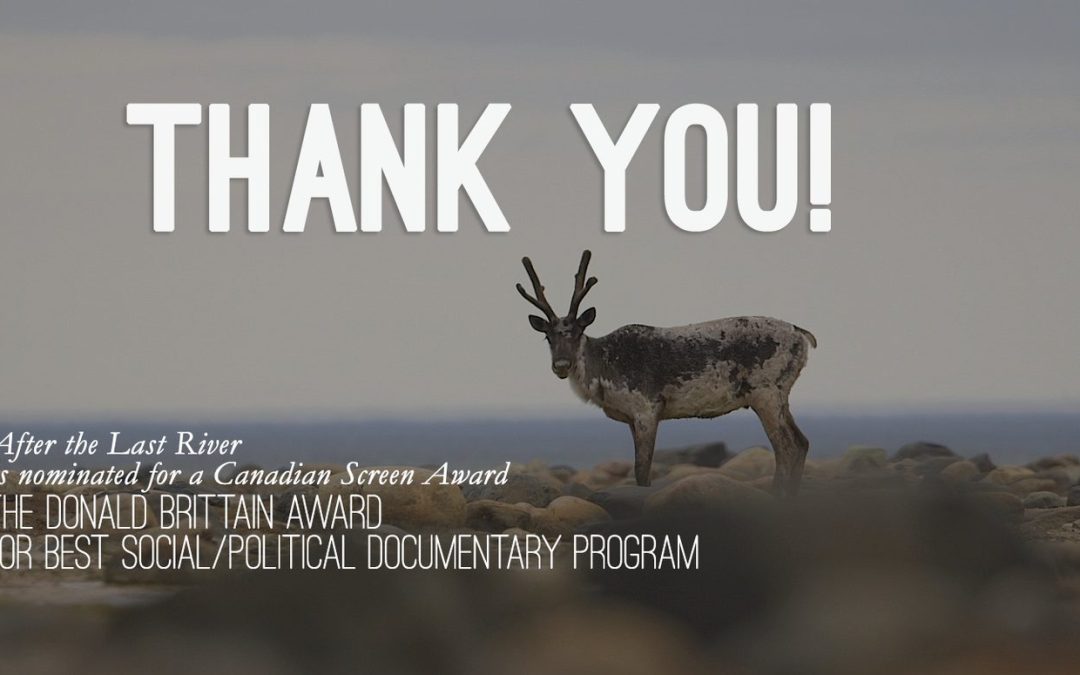
by Deep Green Resistance News Service | Jan 17, 2016 | ANALYSIS, Colonialism & Conquest, Mining & Drilling
By Intercontinental Cry
Documentary follows Attawapiskat’s journey from obscurity into the international spotlight
Downstream from a De Beers diamond mine, the remote community of Attawapiskat, Ontario lurches from crisis to crisis, while facing mounting environmental issues and an inability to directly benefit from resource revenues.
After The Last River – Official Trailer from Victoria Lean on Vimeo.
Filmed over five years, After the Last River is a documentary that follows Attawapiskat’s journey from obscurity and into the international spotlight during the protests of Idle No More. Filmmaker Victoria Lean connects personal stories from the First Nation to entwined mining industry agendas and government policies, painting a complex portrait of a territory that is a imperiled homeland to some and a profitable new frontier for others.
SYNOPSIS
In the shadow of a De Beers mine, the remote community of Attawapiskat lurches from crisis to crisis, while facing mounting environmental issues and an inability to directly benefit from resource revenues. Filmed over five years, After the Last River is a point of view documentary that follows Attawapiskat’s journey from obscurity and into the international spotlight during the protests of Idle No More.
After the Last River is a complex examination of a community under pressure. Poverty, neglect, and isolation combine to force the remote reserve of Attawapiskat into accepting a De Beers diamond mine on it’s traditional territory. As the mine removes billions of dollars worth of diamonds, the promised jobs barely materialize and the community is threatened by potentially devastating contamination.
Filmmaker, Vicki Lean, follows the remote reserve’s five-year journey into the international spotlight. Through interviews with executives and government, and day-in-the-life footage of the community, Lean weaves a tapestry of the issues effecting indigenous rights today.
After the Last River connects personal stories from the First Nation to industry agendas and government policies, painting a complex portrait of a territory that is an imperilled homeland to some and a profitable new frontier for others.












